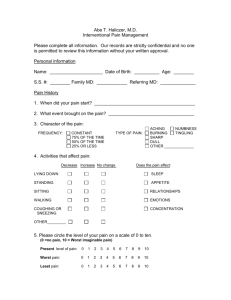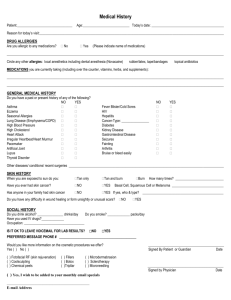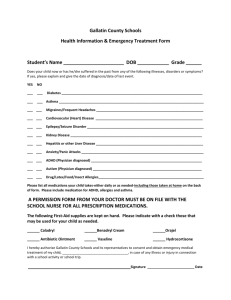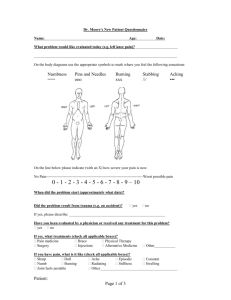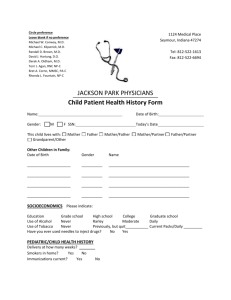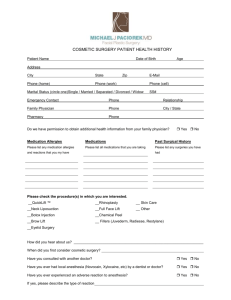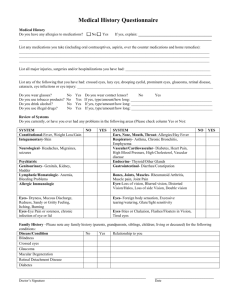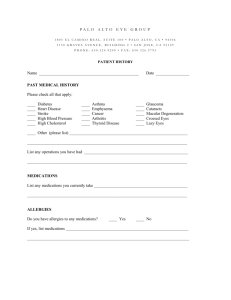Guidelines - Community Networks of Specialized Care
advertisement
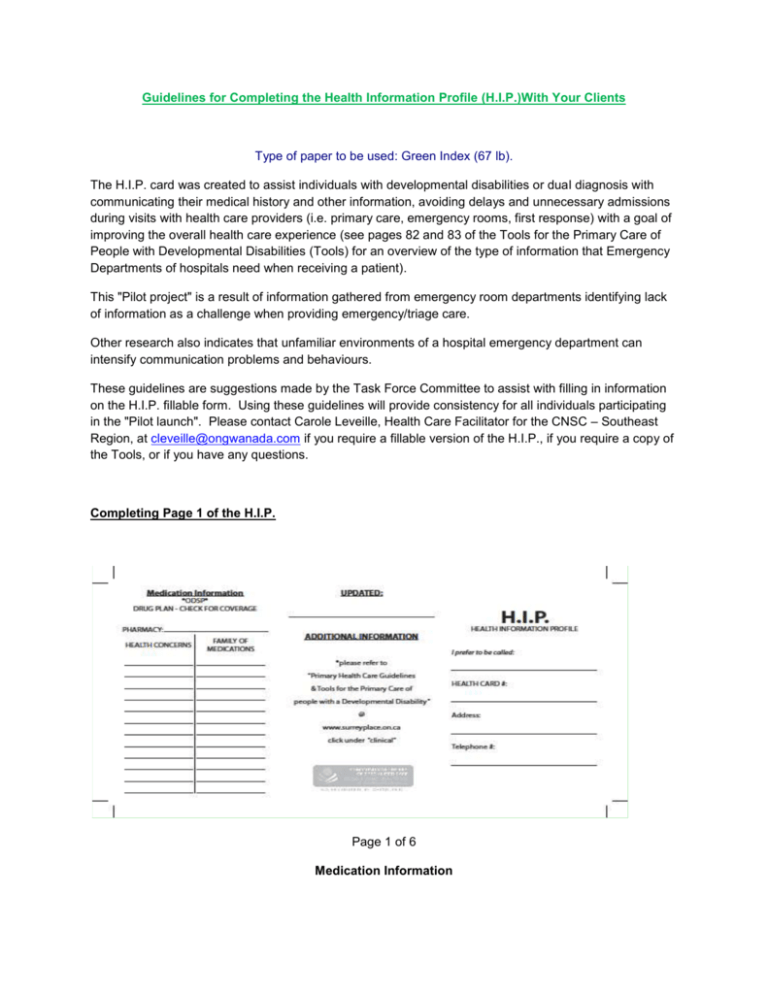
Guidelines for Completing the Health Information Profile (H.I.P.)With Your Clients Type of paper to be used: Green Index (67 lb). The H.I.P. card was created to assist individuals with developmental disabilities or dual diagnosis with communicating their medical history and other information, avoiding delays and unnecessary admissions during visits with health care providers (i.e. primary care, emergency rooms, first response) with a goal of improving the overall health care experience (see pages 82 and 83 of the Tools for the Primary Care of People with Developmental Disabilities (Tools) for an overview of the type of information that Emergency Departments of hospitals need when receiving a patient). This "Pilot project" is a result of information gathered from emergency room departments identifying lack of information as a challenge when providing emergency/triage care. Other research also indicates that unfamiliar environments of a hospital emergency department can intensify communication problems and behaviours. These guidelines are suggestions made by the Task Force Committee to assist with filling in information on the H.I.P. fillable form. Using these guidelines will provide consistency for all individuals participating in the "Pilot launch". Please contact Carole Leveille, Health Care Facilitator for the CNSC – Southeast Region, at cleveille@ongwanada.com if you require a fillable version of the H.I.P., if you require a copy of the Tools, or if you have any questions. Completing Page 1 of the H.I.P. Page 1 of 6 Medication Information PHARMACY: Includes the name and telephone number of the pharmacy most frequently used. HEALTH CONCERNS/FAMILY OF MEDICATIONS: The next section deals with health concerns and the family of medications with which each concern is treated. The family of medications is used here because although specific medications may change, the family to which the medications belong to is less likely to change. Examples of medications that belong to families include, Lorazepam, Clonazepam which belong to the Benzodiazepine family; Mirtazapine, Sertraline, and Amitriptyline all belong to the antidepressant family; Carbamazepine, Valproic Acid, and Gabapentin all belong to the anticonvulsant family; Olanzapine, Respiridone, and Haloperidol all belong to the antipsychotic family. The family of medications used to treat a health concern provides sufficient information for emergency room/triage staff and other health care providers to make medical decisions while keeping information accurate through many potential medication changes. Examples of health concerns treated by families of medications include but are not limited to the following. Depression Bipolar disorder GERD Chronic Constipation ADHD Arthritis Schizophrenia Anxiety Antidepressants Mood stabilizers Antacids Stool softeners Stimulants Anti-inflammatories Antipsychotics Benzodiazepines In addition to being more accurate, family names of medications also protect a person’s privacy. Knowing the exact medication that a person is taking may open a person up to prejudice or theft. If you require more information about which medications belongs to which family, please contact your pharmacist. Updated and Additional Information UPDATED: Date on which the last revision of the client’s H.I.P. was completed. ADDITIONAL INFORMATION: Encourages health care providers to looks up the “Primary Health Care Guidelines & Tools for the Primary Care of people with a Developmental Disability.” These guidelines can be found on the web site of the Surrey Place Centre at www.surreyplace.ca, by clicking under “clinical”. Page 2 of 6 H.I.P. – Health Information Profile I PREFER TO BE CALLED : Optional For confidentiality reasons, it is important to note that the person's last name should not appear as it will be provided through the Health Card #. It should only contain the name the person prefers to use. Since the name or nickname is the person’s primary identifier, using the right name can strengthen relationships between health care providers and using the wrong name can have the opposite effect. For instance, a person named Joseph may prefer to be called Joey or if named Mark, the person may prefer to be called “Bear”. HEALTH CARD NUMBER: Indicate Health Card # without the version code. The version code is not needed to obtain the person's record and leaving it out adds a layer of security against Health Card fraud. ADDRESS AND TELEPHONE NUMBER: Optional Completing Page 2 of the H.I.P. Page 3 of 6 Health Information ALLERGIES: Under allergies please include all allergies to medications and/or environmental allergies along with the person’s reaction to each allergy, if known. Examples of medication allergies include penicillin or sulpha drugs. Examples of environmental allergies include allergies to latex or perfume. If you are unsure of any known allergies, write “no known allergies”. Please be specific when you are listing allergies and the person’s reaction to each allergy. RELEVANT MEDICAL DIAGNOSIS: Should include a list all current diagnoses. This information must come from a documented diagnosis and must be specific. For example, a person has been diagnosed with schizophrenia, write schizophrenia and not mental illness. This is also where developmental disability would be written. It should also include any heart conditions, circulatory conditions, digestive conditions, etc. PSYCHIATRIC ADMISSIONS: Check the "yes" box if the person has ever had an admission to a psychiatric hospital or a general hospital psychiatric ward. DUAL DIAGNOSIS: This information must come from a documented psychiatric diagnosis. Check "yes" or "no" Communication and Behaviour The communication and behaviour section includes information about environmental and internal triggers that could elicit response behaviours in a person, what response behaviours look like for that person, and how to help the person regain control after a response behaviour has occurred. It also includes information about the preferred method of communication, usual response to pain or distress, and lifestyle (see pages 18 and 19 of the Tools for suggestions for communicating effectively with people with developmental disabilities and see pages 72 to 76 for a tool to help caregivers assess behaviour problems in people with developmental disabilities). CAUTIONS: Can include information about anything that can elicit a response behaviour. For example, if a person is always agreeable, afraid of needles, not medication compliant, has a speech impediment, etc. BEHAVIOURAL TRIGGERS: Can include information about any environmental or internal triggers for response behaviours. For example, if hearing the word “epilepsy” is a trigger for anxiety or if loud noises or high or low blood sugar trigger behaviours then you would write this under behavioural triggers. RESPONSE BEHAVIOURS: Can include information about what the response behaviours look like. Be as specific as possible here. Instead of writing self-injurious behaviour, write “punches himself/herself”, “pinches himself/herself”, “cuts himself/herself”, “bangs his/her head”. If the behavioural trigger causes the person to hit, punch, kick, scratch, or pinch other people, or causes the person to withdraw emotionally or behaviourally include this information. Page 4 of 6 HOW TO HELP: Can include any strategies that work for helping a person regain control after a response behaviour has occurred. For instance, if removing the person to a quiet area, checking the person's blood sugar, or turning off some lights may help the person regain control after a response behaviour, you would put that information under "how to help". COMMUNICATION: The person's preferred method of communication. Examples of communication methods can include: Preferred language spoken, PECS, sign language, reading and writing skills, any combination of sounds, movements, or pictures as a method of communication. USUAL RESPONSE TO PAIN OR DISTRESS: Is the person’s usual response to pain or distress. Examples of responses can include: crying, screaming, yelling, punching, kicking, withdrawing, etc. If the person has high or low tolerance for pain. LIFESTYLE: Can include any pertinent information about the way the person lives their life. Examples include; attends day program, school, works, smoking, alcohol or drug use, physical activities, lives independently or with family, has a pet, practices a religion, etc. This information may provide health care providers with valuable information regarding specific health concerns. It also helps the health care provider connect with the person, which can build trust and ease anxiety. Contact information Medical and agency contacts PHYSICIAN CONTACT: Include the name and phone number of the person's regular family physician. AGENCY CONTACT: Include the name and phone number of the primary agency that knows the person well. In addition, the name and work phone number of the person's primary worker could also be added. EMERGENCY CONTACT: Include the name and phone number of the next of kin. SUBSTITUTE DECISION MAKER: Include the name and phone number of the legally appointed substitute decision maker. If there is no substitute decision maker, put not applicable See pages 11 to 17 of the Tools for a discussion of informed consent for people with developmental disabilities. Page 5 of 6 Health Information Task Force Members Deidre Gillespie (Chair) Carole Léveillé (Secretary) Alison Treadgold Mike Sherboneau Janet Barry Lisa MacIntosh Liz Kacew Fred Happy Dr. Ullanda Niel Nancy Nesbitt-Boucher 613-548-4417 Ext: 3305 Page 6 of 6

